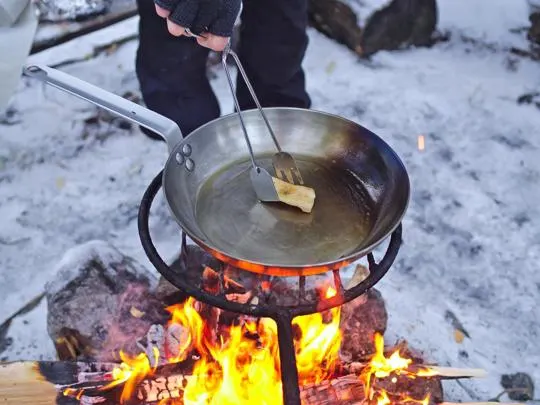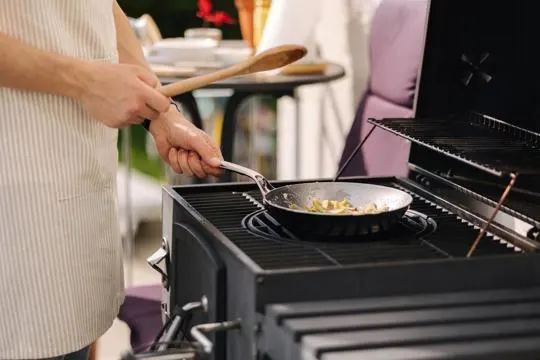Ever found yourself staring at pans in the kitchen, wondering which one to pick for your next culinary masterpiece? Stainless steel and carbon steel pans sit on the shelf, gleaming under the kitchen lights. They seem to whisper, “Pick me!”
We’re here to unravel this mystery. Both boast unique perks. Stainless steel, the durable star, shines in countless kitchens.
Carbon steel, the robust underdog, heats up quick and even. Ever tried whipping up a storm with these pans? We sure have.
Stainless steals the show for easy maintenance, while carbon steel promises a top-notch sear. Opting between them feels like choosing a favorite child.
Every cook’s dilemma, yet knowing the difference can elevate your cooking game.
What is Stainless Steel?

Popular for its durability and corrosion resistance, stainless steel is a go-to material.
It’s a mix of iron, chromium, and more – perfect for various uses.
Chefs and home cooks love stainless steel pans.
They heat up and stay hot, plus won’t change the flavor or color of food.
Cleaning and maintenance is simple – no staining or rust.
Plus, stainless steel pans are strong.
They can stand high temps and won’t warp or break.
They’re great for stovetop or oven use and last a long time.
Plus, they’re compatible with induction cooktops.
But, watch out for sticking when cooking certain foods.
Preheat the pan or use oil to minimize it.
What is Carbon Steel?

Carbon steel has more carbon than other types.
This gives it added strength and hardness.
It is used in manufacturing for tools, machinery, and auto parts.
Construction also uses carbon steel due to its durability and wear-resistance.
Heat conductivity makes carbon steel great for cookware like pans and skillets.
Differences Between Stainless Steel and Carbon Steel Pans

Stainless steel and carbon steel pans are unique.
Composition, heat conductivity, maintenance, and cooking performance all vary.
Both have advantages and disadvantages, so it’s important to consider these before making a decision.
Composition and Construction
Stainless steel and carbon steel pans differ in composition and construction.
Stainless steel pans are made from a blend of iron, chromium, and nickel, providing strength and rust-resistance.
Carbon steel pans contain only iron and carbon, making them lighter and more responsive to heat.
Both have unique qualities making them suitable for different cooking tasks.
Stainless steel pans are renowned for their durability and non-reactive surface.
The chromium and nickel addition to iron forms a protective layer, preventing corrosion.
This makes them great for acidic foods like tomatoes or lemon juice, as they won’t affect the flavor.
Plus, stainless steel can handle high temperatures without warping or damaging.
Carbon steel pans are ideal for tasks needing precise temperature control, such as searing and stir-frying.
Their heat conductivity is excellent, heating up quickly and evenly distributing the heat.
Over time, with proper seasoning, they develop a natural non-stick patina, making them even better.
Stainless steel lacks this natural non-stick quality, but can be used with added fats or oils.
Heat Conductivity and Distribution
Heat conduction and distribution are key to assessing the performance of stainless steel and carbon steel pans.
Both have different properties when it comes to heat.
Stainless steel pans have low heat conduction.
This means they take more time to heat up than carbon steel pans.
But they make up for it by spreading heat evenly across the surface.
This is great for slow dishes, like simmering sauces or braising meats.
Carbon steel pans have great heat conduction.
They heat up fast and respond to temperature changes quickly.
This allows for fine control over cooking, making them ideal for high-temperature recipes like searing or stir-frying.
The downside is they can develop hot spots if not preheated properly or if the heat source isn’t even.
Stainless steel pans have an advantage.
They can retain heat for longer.
This is useful when keeping food warm or maintaining temperature during cooking.
In conclusion, stainless steel pans don’t have the same heat conduction as carbon steel.
However, they excel in heat distribution and retention.
Carbon steel pans are better for rapid heating and precise temperature control.
Knowing these differences will help you pick the right pan for your needs.
Durability and Maintenance
Durability and maintenance are important for deciding between stainless steel and carbon steel pans.
Stainless steel pans are solid and resist rust, corrosion, and staining.
Cleaning them is easy – soap and water will do.
Carbon steel pans are tough too, but need more maintenance.
They must be seasoned regularly to keep their non-stick surface and avoid rusting.
Both types of pans are durable, yet have different maintenance needs.
This should be kept in mind when selecting.
Price Range
Stainless Steel vs Carbon Steel Pan: Any Difference?
Price-wise, stainless and carbon steel pans vary.
Stainless steel pans cost more.
This is because stainless steel is a quality material, with durability and corrosion resistance.
Plus, the manufacturing process is complex, making it pricier.
Carbon steel pans are usually cheaper.
The manufacturing process is simpler and the material less costly than stainless steel.
So, carbon steel pans are a budget-friendly option that still performs well.
Similarities Between Stainless Steel and Carbon Steel Pans

Stainless steel and carbon steel pans are both durable and can handle high temperatures.
Plus, they’re good heat conductors.
Both types are suitable for gas, electric, and induction cooktops.
But, stainless steel pans are non-reactive, meaning they won’t affect acidic or alkaline foods.
Carbon steel pans require seasoning to become non-stick.
Carbon steel pans are lighter than stainless steel and have excellent heat retention.
Stainless steel pans may take longer to heat, yet are more durable and rust-resistant.
Stainless steel pans are easier to clean – they’re dishwasher safe.
Carbon steel pans need special care, like hand washing and re-seasoning, to maintain their non-stick properties.
It comes down to personal preference and cooking needs.
Both stainless steel and carbon steel offer great options for yummy kitchen creations.
Cooking Performance and Versatility
When choosing between a stainless steel pan and a carbon steel pan, cooking performance and versatility are crucial.
Both have unique qualities that influence their kitchen performance.
Stainless steel pans distribute heat evenly, ideal for searing meats or browning veggies.
They are non-reactive, making them perfect for acidic foods.
Plus, they can go from stovetop to oven, offering versatile cooking methods.
On the flip side, carbon steel pans respond to changes in heat, allowing for precise temperatures.
They heat up quickly and cool down rapidly, providing more control.
Plus, they develop a natural non-stick patina with correct seasoning, ideal for delicate foods.
They are lightweight and simple to maneuver, making flipping and tossing food easy.
In the end, the choice between these two pans depends on individual preference and the cooking techniques one prefers.
Stainless steel is great for even heat and compatibility with different ingredients.
Carbon steel excels in temperature responsiveness and forming a natural non-stick surface.
Conclusion
In conclusion, stainless steel and carbon steel pans are both brilliant options when it comes to cooking.
Carbon steel pans can be cheaper and provide the serious chef with extra attention to temperature control while stainless steel pans are great for cooking a variety of foods easily and will look good in your kitchen, too.
Ultimately, the choice is yours and it’s important to consider all factors before coming to an agreement on either option.
For those who enjoy accuracy in their cooking and value their money spent, then carbon steel might be the right choice for you.
If however, you just want a pan that looks great and can withstand some wear-and-tear, then stainless steel could work out better.
Knowing what makes these two metal classes different will help you make an educated decision about which one is best for you.

Leave a comment